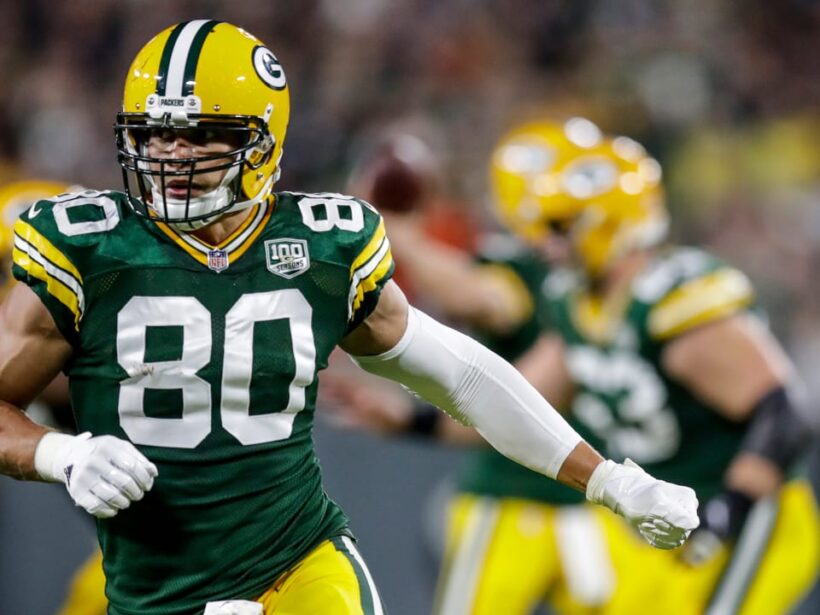One of the more disappointing areas of the Green Bay offense has been their tight end group, which they have thrown money at with Jimmy Graham, which unfortunately has not worked out. With an easy out this off-season to shed some money and start fresh, GB is in a good position to improve upon the role of the TE in their schemes.
Here is the next article looking back at position groups for 2019.
Jimmy Graham
Graham has set the high-water mark for annual TE salary, yet his on-field stats have come nowhere close to justifying his bank account stats. A proven veteran presence that has turned into a drop machine, his role in the offense was one that head coach Matt LaFleur has been great at getting highly involved when in Tennessee, but the lack of consistent production has hindered that role expansion.
Signed to a three-year, $30 million deal in March 2018, with the only guaranteed money being the $11 million signing bonus he received. His current cap number for 2020 sits at $11,666,668, a million dollars less than what he was worth last year against the cap.
If he was to be released or traded this off-season before June 1, the team would save $8 million while accruing $3,666,668 in dead money on their cap sheet, according to Over the Cap.
Graham has the 2nd-highest cap hit for a TE in the league, the 5th-highest Packer cap hit, and the 124th-highest cap hit in the NFL. He has the highest yearly average salary for a TE too, yet his time on GB should be dwindling down to its very end.
Rest of the TE’s
Rookie Jace Sternberger from Texas A&M, I drafted player Robert Tonyan, and glue-guy veteran Marcedes Lewis made up the rest of the team’s TE ranks. Of the three, Sternberger looks to be the guy with the highest ceiling, as the 3rd-round draftee was finally able to mesh with Aaron Rodgers after missing a good chunk of the season.
Tonyan has shown flashes while in GB, but he seems to be capped at a team’s 3rd-best TE, with the potential to be the 2nd. He represents another undrafted gem that GB unearthed, and he has been a pleasant surprise for the team.
Lewis is on the tail-end of his career, and while he is close to retirement, he is still a valued member of the roster. Getting along well with Rodgers and playing a small role in the offense has become Lewis’ forte, which plays into the team structure just fine.
Moving Forward
The team can use both free agency and the draft to reload at this position, as both areas have weapons for the team to use.
If they are looking to throw a bunch of money at a TE again, then the likes of Austin Hooper and Hunter Henry are the likeliest candidates.
Hooper, formerly of the Atlanta Falcons, was a huge security blanket for Matt Ryan and would thrive in an offense that so desperately needs a solid TE. The more expensive of the two players, the team may need to throw even more money at Hooper annually, which is scary due to his MCL injury history.
For Henry, having caught passes from Phillip Rivers since he was drafted afforded him a luxury that guaranteed him seeing a lot of balls come his way. While AR does not necessarily utilize safety valves as much as he should, Henry’s abilities, especially in the red zone, would come in handy in ‘20. He also has a colorful injury history that throws up some red flags too.
In the draft, the class is led by Notre Dame prospect Cole Kmet and LSU player Thaddeus Moss. Kmet is 6-5 and a potential late first-round selection, and Moss’ last name and who his father is would make for quite an interesting storyline come the draft.
Other prospects include Adam Trautman of Dayton, Hunter Bryant (Washington), Albert Okwuegbunam (Missouri), Colby Parkinson (Stanford), and Jared Pinkney (Vanderbilt), with both Parkinson and Pinkney being the two better prospects of the group.
Mike Johrendt has been an avid fan of the Packers ever since he can remember. He is now a writer at PackersTalk and you can follow him on Twitter at @MJohrendt23
뿓뿓뿓

